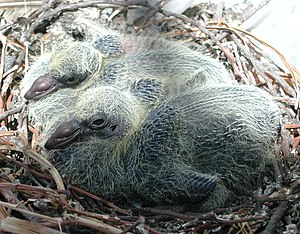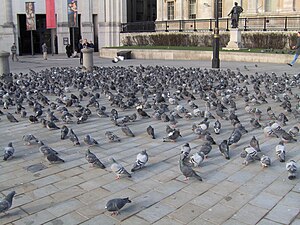Difference between revisions of "Field Guide/Birds/Columba livia"
(No difference)
|
Revision as of 13:16, 27 February 2006
The Rock Pigeon (Columba livia), is a member of the bird family Columbidae, doves and pigeons. The bird is also known by the names of feral pigeon, homing pigeon or domestic pigeon. In common usage, this bird is often simply referred to as the "pigeon". The species was commonly known as Rock Dove until the British Ornithologists' Union and the American Ornithologists' Union changed the official English name of the bird in their regions to Rock Pigeon.
The Rock Pigeon has a restricted natural resident range in western and southern Europe, North Africa and into southwest Asia. Its habitat is natural cliffs, usually on coasts. Its domesticated form, the feral pigeon, has been widely introduced elsewhere, and is common, especially in cities, over much of the world. In Britain, Ireland, and much of its former range, the Rock Pigeon probably only occurs pure in the most remote areas. A Rock Pigeon's life span is anywhere from 3-5 years in the wild to 15 years in captivity, though longer-lived specimens have been reported.
The species was first introduced to North America in 1606 at Port Royal, Acadia (now Nova Scotia).
The Rock Pigeon is 30-35 cm long with a 62-68 cm wingspan. The white lower back of the pure Rock Pigeon is its best identification character, but the two black bars on its pale grey wings are also distinctive . The tail is margined with white. It is strong and quick on the wing, dashing out from sea caves, flying low over the water, its white rump showing well from above.
The head and neck of the mature bird are a darker blue-grey than the back and wings; the lower back is white. The green and lilac or purple patch on the side of the neck is larger than that of the Stock Dove, and the tail is more distinctly banded. Young birds show little lustre and are duller. Eye colour of the pigeon is generally an orange colour but a few pigeons may have white-grey eyes. The eyelids are orange in colour and are encapsulated in a grey-white eye ring.
Little parties will circle over the sea and the cliff tops, when the white under wing is equally conspicuous. In its flight, behaviour, and voice, which is more of a dovecot coo than the phrase of the Wood Pigeon, it is a typical pigeon. Though fields are visited for grain and green food, it is nowhere so plentiful as to be a pest.
The bowing courtship, when the metallic lustre of the neck is fully displayed, often takes place on ledges where Guillemots and Razorbills sit.
The nest is usually on a ledge in a cave; it is a slight structure of grass, heather, or seaweed. Like most pigeons it lays two white eggs. The eggs are incubated by both parents for about 18 days.
The nestling has pale yellow down and a flesh coloured bill with a dark band. It is tended and fed on "milk" like other doves. The fledging period is 30 days.
Domestication
Rock Pigeons have been domesticated for several thousand years, giving rise to the domestic pigeon. Trained domestic pigeons are able to return to the home loft if released at a location that they have never visited before and that may be up to 1000 km away. A special breed, called homing pigeons has been developed through selective breeding to carry messages and members of this variety of pigeon are still being used in pigeon racing.
Pigeons are also bred for meat and by fanciers to develop many exotic forms. Among those forms are the carrier pigeons, a variety of pigeon with wattles and a unique, almost vertical, stance (pictures).
Pigeons' extraordinary navigation abilities are in part due to the fact that they are able to sense the Earth's magnetic field with tiny magnetic tissues in their head. This is all the more surprising as they are not a migratory species.
Many domestic birds have escaped or been released over the years, and have given rise to the feral pigeon. These show a variety of plumages, although some look very like the pure Rock Pigeons. The scarcity of the pure wild species is due to interbreeding with feral birds.
Domestic pigeons are commonly used in laboratory experiments in biology, medicine and cognitive science. They have been trained to distinguish between cubist and impressionist paintings, for instance. In another project, pigeons were shown to be more effective than humans in spotting shipwreck victims at sea. Current (2004) research in pigeons is widespread, encompassing shape and texture perception, exemplar and prototype memory, category-based and associative concepts, and many more unlisted here (see Pigeon intelligence and discrimination abilities of pigeons).
Feral pigeons in cities
Feral pigeons, also called city doves or city pigeons, find the ledges of high buildings a perfect substitute for sea cliffs, and have become abundant in cities all over the world. Some city squares are famous for them, for example:
- Trafalgar Square - London
- Dam Square - Amsterdam
- Martin Place - Sydney
- Piazza San Marco - Venice
- Misir Carshisi- Istanbul
- Rynek Główny- Cracow
However, feeding pigeons is now forbidden in many cities, including some of these public places where feeding them was once common, such as Trafalgar Square. Pigeons are widely considered vermin, owing to concerns that they spread disease, damage property, cause pollution with their excrement, and drive out other bird species; they are sometimes dubbed sky rats. Some fences and ledges of buildings are equipped with strips of bird control spikes to discourage pigeons from staying there. In a small minority of cities, feeding pigeons is forbidden because they become overweight and are unable to avoid vehicles.
See also
References
- Collins Bird Guide by Mullarney, Svensson, Zetterström and Grant ISBN 0-00-219728-6
- Template:ITIS
External links
- Why do pigeons bob their heads? (from The Straight Dope)
- BBC Life and Nature (from the BBC)
bg:Скален гълъб cs:Holub skalní da:Klippedue de:Felsentaube fr:Pigeon biset nl:Rotsduif ja:カワラバト pl:Gołąb skalny ru:Голубь обыкновенный fi:Kesykyyhky sv:Klippduva tr:kaya güvercini zh:原鸽




